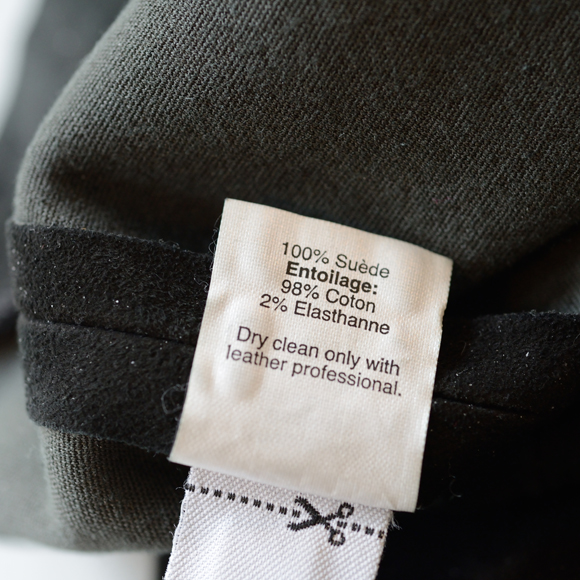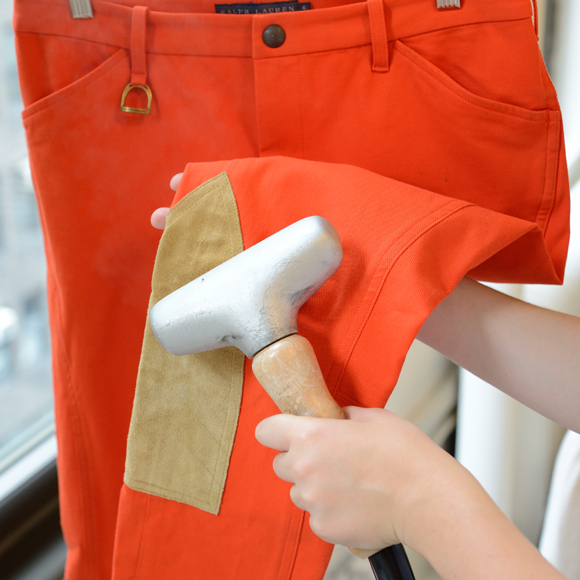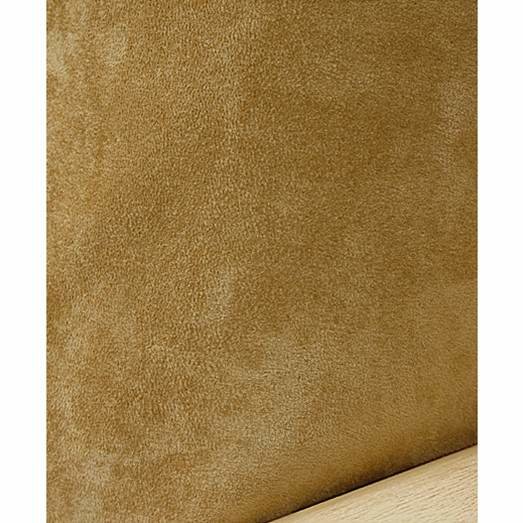What is Suede?
Suede is a type of leather that is made from the soft underside of an animal, giving it a velvety texture and smooth feel. It is known for being long-lasting despite being thinner than traditional leather. The “nap” or tiny raised hairs on the surface of suede will vary in texture and size depending on the animal the suede is derived from, and the process of making the garment. As suede is thinner than regular leather, it is a more pliable and breathable fabric and is often used for footwear and other accessories such as gloves. Microsuede or microfiber suede is derived from polyester fabric, and is created to mimic the soft, supple feeling of real suede. Microsuede is also generally more resistant to stains and wear and is often found in upholstery. Most microsuede items are washable or spot-treatable, while genuine suede is generally non-washable.

Can you wash suede? Here at The Laundress, we don't like to give specific cleaning advice on how to clean suede as the material on your favorite suede jackets, and shoes at home as this material has many different options for finishes, which makes it impossible for us to know which type you're working with. In addition, your suede coat or jacket may vary by lining type and may have embellishments that require special care. In order to preserve your suede item for years to come, it’s important to check the item’s tag for manufacturer recommendations before proceeding with treatment.
Our general guideline for washing your suede jackets and other items is as follows:
Not Washable: If a leather item is labeled "not washable" or "dry clean only," don't wash or spot treat it. Trust us. Can you dry clean suede? The answer is a little complicated. Generally, most real suede made from animal hide should not be exposed to water or heavy chemical solvents, as they can permanently alter the item’s finish. However, certain items labeled “not washable” may have spot-treatable linings made from silk or synthetic fabrics. A specially-designed suede brush or suede eraser can also be great for cleaning suede shoes, suede boots, and other items that are prone to dirt stains. Always consult a leather professional before attempting to treat your suede item at home to prevent water damage.
Washable: We have successfully washed many leather items labeled "washable" as well as most non-leather items with leather trim: patches, collars, zip pulls, and binding. Simply test the leather item before you wash it. Using a dampened clean cloth, gently blot an inconspicuous area of the item such as the inside of a cuff or collar. After you dampen the suede, look for discoloration, spots, or other changes once the area has dried. If no water marks or stains remain, you can proceed with laundering or spot treating the garment per the tag directions. Most washable leather items are considered “delicate” and should be treated using cool water and an appropriate gentle detergent such as Wool & Cashmere Shampoo. Can you put suede in the dryer? Even if a washable suede item is tagged as “machine dry” or “machine dry low”, we would caution against machine drying for an extended period of time, as most fabric damage to delicates does occur during this stage.
Leather trim: We have successfully washed many leather trim items labeled "dry clean" or "dry clean only." Most leather trim is made from "garment washed" leather. This type of leather has already been washed during the production stage, which means it should now be washable as part of the garment. If your item has suede or suede-like leather trim that is specifically tagged as washable, be sure to use cold water and an enzyme-free detergent, such as Wool & Cashmere Shampoo. For items tagged “dry clean”, always spot test before laundering at home. Learn more about spot testing in our guide. It’s important to bear in mind that certain structured items such as jackets and coats that are made from a “washable” fabric such as wool or cotton but contain leather trim and lining details may change their shape if submerged in water. It’s better to play it safe and steam or spot-clean these items rather than launder them at the risk of damage.
Spot Treating: As mentioned above, some suede items can be carefully spot treated for stain and dirt removal. A good rule of thumb is to never, ever use a rubbing motion over a stain on suede, as it can press the mark further into the fabric, making it more difficult to remove. Before starting, always be sure to check the item’s tag for the manufacturer’s care recommendations.
Sticky Stains: For sticky marks on suede from sticker or tag residue, first gently remove the sticker or tag, using a blunt knife or cardstock if needed. The remaining sticky residue can be removed with a suede brush (or a clean, dry stain brush or toothbrush, using short strokes. In a pinch, an art or pencil eraser can also work to lift residue, but take care to avoid rubbing and instead use short strokes, letting the eraser lift the residual sticker glue.
Tough Oil & Food/Drink Stains: If your suede item has incurred a heavier stain, proceed with care. For suede items, it’s always best to consult a leather professional first before treating at home. To start, using a clean, dry cotton ball can help to soak up excess stain residue on the surface of your suede item to avoid a larger stain. Place the cotton ball on the stained area, and lightly dab until the cotton is saturated, then repeat with a new cotton ball until the majority of the stain has lifted. Discoloration from oily stain residue can be treated with a tiny amount of rubbing alcohol—soak a cotton ball in rubbing alcohol and gently dab the stain (don’t rub!), letting it slowly transfer from the suede to the cotton ball. Repeat as needed.
"Can you iron suede" is a question we get a lot. It’s important to bear in mind that suede is quite heat-sensitive, and cannot be ironed like a more durable cotton or synthetic item. High heat combined with the typical back-and-forth ironing motions can completely destroy the finish of your suede item, as it will crush or flatten the nap. If needed, it’s best to attempt to steam to remove unwanted heavy wrinkles, and get creases out. Steaming also helps to remove dirt, oils, and surface odors that can settle into fabric over time. Position the steamer head a few inches from the inside of the garment and proceed with steaming. The fabric lining of suede items can be freshened and revived using steam, but take care not to touch the suede directly with the steamer head, and not to oversaturate the suede item with water while steaming. If needed, periodically let the item “rest” during the steaming process to avoid water marks. Always let your suede item dry completely before wearing again or storing.
If your wrinkles are beyond the power of your steamer and you must iron, proceed with extreme caution. First, set your iron to a low or medium heat. Then, place a protective cotton cloth between your iron and the item. Your suede piece should be nap side down, facing away from the iron (this may mean turning your item inside-out). Be sure to carefully smooth out the suede completely before placing the cloth to avoid creating more creases. Once the iron is ready, gently place it on the area that needs to be de-wrinkles, press lightly for a second or two, then lift. Do not move the iron back and forth while it is in contact with the garment. This is a slow process—please bear in mind that pressing the iron harder or holding it down for longer will potentially ruin the item, so work in short, light strokes over and over until you achieve the desired finish. Once the process is completed, use a suede brush or toothbrush to brush gently over the suede’s nap, carefully “fluffing” the surface.
To freshen your suede item between wears, spritz with your favorite fabric refresher. Take care to avoid spritzing the suede directly from close range, instead, spritz the lining or underside of the garment from 6-8 inches away to avoid water stains. Spritz after steaming for a great alternative to achieving a “dry clean” finish on suede items at home.


Always store items clean. We like to use a steamer to give suede items like jackets and coats a refresh ahead of storing for the off season. After steaming, always leave out your suede item, such as a jacket or shoes to dry fully before storing. Additionally, be sure to check for dirt and remove stains before putting items away for an extended period, as this can make them harder to remove.
We recommend storing in a breathable cotton or canvas zippered bags to help protect items from bugs, mold, mildew, dust, or general “mustiness”. Storing in plastic encourages yellowing and can trap mildew-causing moisture, a prime environment for bugs. Placing a lavender pouch inside your storage bag along with your suede items can help to maintain freshness during storage.
All techniques are based on textile science. Not all garments perform and react as science would predict.












